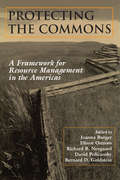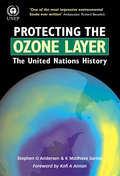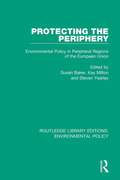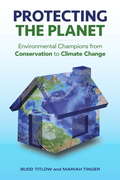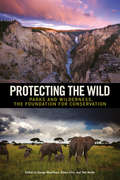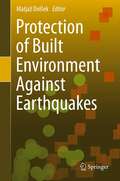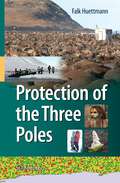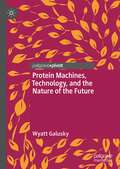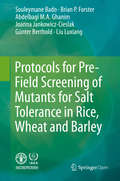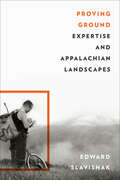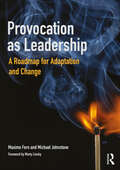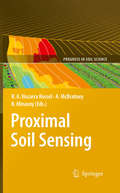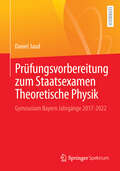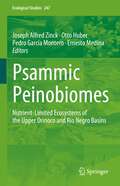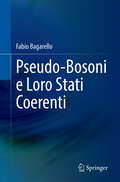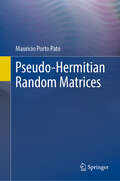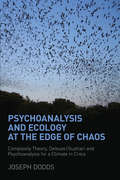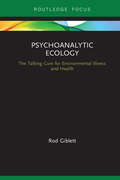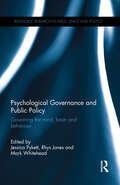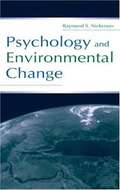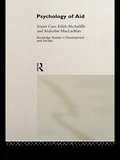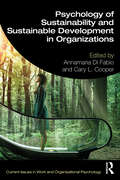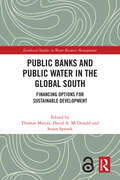- Table View
- List View
Protecting the Commons: A Framework For Resource Management In The Americas
by Joanna Burger Elinor Ostrom Bernard D. Goldstein David Policansky Richard NorgaardCommons -- lands, waters, and resources that are not legally owned and controlled by a single private entity, such as ocean and coastal areas, the atmosphere, public lands, freshwater aquifers, and migratory species -- are an increasingly contentious issue in resource management and international affairs.Protecting the Commons provides an important analytical framework for understanding commons issues and for designing policies to deal with them. The product of a symposium convened by the Scientific Committee on Problems of the Environment (SCOPE) to mark the 30th anniversary of Garrett Hardin's seminal essay "The Tragedy of the Commons" the book brings together leading scholars and researchers on commons issues to offer both conceptual background and analysis of the evolving scientific understanding on commons resources. The book: gives a concise update on commons use and scholarship offers eleven case studies of commons, examined through the lens provided by leading commons theorist Elinor Ostrom provides a review of tools such as Geographic Information Systems that are useful for decision-making examines environmental justice issues relevant to commons .Contributors include Alpina Begossi, William Blomquist, Joanna Burger, Tim Clark, Clark Gibson, Michael Gelobter, Michael Gochfeld, Bonnie McCay, Pamela Matson, Richard Norgaard, Elinor Ostrom, David Policansky, Jeffrey Richey, Jose Sarukhan, and Edella Schlager.Protecting the Commons represents a landmark study of commons issues that offers analysis and background from economic, legal, social, political, geological, and biological perspectives. It will be essential reading for anyone concerned with commons and commons resources, including students and scholars of environmental policy and economics, public health, international affairs, and related fields.
Protecting the Ozone Layer: The United Nations History
by Stephen O Andersen K Madhava SarmaIn the 1970s the world became aware of a huge danger: the destruction of the stratospheric ozone layer by CFCs escaping into the atmosphere, and the damage this could do to human health and the food chain. So great was the threat that by 1987 the UN had succeeded in coordinating an international treaty to phase out emissions; which, over the following 15 years has been implemented. It has been hailed as an outstanding success. It needed the participation of all the parties: governments, industry, scientists, campaigners, NGOs and the media, and is a model for future treaties. This volume provides the authoritative and comprehensive history of the whole process from the earliest warning signs to the present. It is an invaluable record for all those involved and a necessary reference for future negotiations to a wide range of scholars, students and professionals.
Protecting the Periphery: Environmental Policy in Peripheral Regions of the European Union (Routledge Library Editions: Environmental Policy #1)
by Steven Yearley Susan Baker Kay MiltonFirst published in 1994. ln Protecting the Periphery the editors present a series of papers revealing the impact of EU policies on environmental quality in regions at the edge of the European Union and in those lying just outside it. In many cases these regions contain habitats and landscapes of international importance; they have also often escaped some of the environmental damage caused by industrialization. But, as the papers' reveal, attempts by the EU to safeguard these environmental benefits are often contradicted by the EU’s own development policies, bringing air pollution from new roads, contamination from new industries, and leading to habitat destruction from modern agricultural practices and increases in tourism. As the Union pushes for the deepening of the integration process, including completing the internal market, the pressures on the periphery's environment are increasing. Furthermore, the efforts of the periphery to catch-up economically with the developed core can often heighten the tension between economic considerations on the one hand and the need for environmental protection on the other. The studies in this book examine the ambivalent responses to EU environmental policy among policy-makers and environmentalists in the periphery. Both the willingness as well as the capacity of the periphery to protect its environmental heritage are explored. In particular, the administrative capacity, institutional arrangements, political culture as well as economic development needs are taken into account in an examination of the nature of the periphery’s response to and implementation of Union environmental policy. The book will appeal to policy-makers and academics in the countries of the European periphery and to analysts of European policy-making everywhere, especially those concerned with environmental policy and politics.
Protecting the Planet: Environmental Champions from Conservation to Climate Change
by Budd Titlow Mariah TingerClimate change is often associated with predictions of dire calamities. But in the past, heroic individuals have stepped forward to meet even the most ominous ecological challenges. This book tells an inspirational story--a story both of pioneering environmentalists who raised our collective consciousness regarding nature's value and heroes of today who are working to secure a sustainable future.The authors begin with the mounting evidence for climate change as seen in rising carbon dioxide levels, higher global temperatures, melting ice sheets, and sea level rise. They then review the history of the US environmental movement, focusing on the key people who changed our understanding of the human impact on our natural surroundings. These include John James Audubon, Henry David Thoreau, John Burroughs, Theodore Roosevelt, John Muir, Bob Marshall, Roger Tory Peterson, Aldo Leopold, Rachel Carson, David Brower, Barry Commoner, Donella Meadows, and many more. Turning to the present, the authors recount the activities of people currently pursuing remedies for climate change--scientists, researchers, activists, artists, and celebrities. Much of this information is based on recent personal interviews.They conclude with a set of actionable strategies, demonstrating that there are good reasons to hope that we can achieve a sustainable lifestyle, protect our planet as our home, and ensure the future for our children.From the Hardcover edition.
Protecting the Wild
by Tom Butler George Wuerthner Eileen CristProtected natural areas have historically been the primary tool of conservationists to conserve land and wildlife. These parks and reserves are set apart to forever remain in contrast to those places where human activities, technologies, and developments prevail. But even as the biodiversity crisis accelerates, a growing number of voices are suggesting that protected areas are passé. Conservation, they argue, should instead focus on lands managed for human use--working landscapes--and abandon the goal of preventing human-caused extinctions in favor of maintaining ecosystem services to support people. If such arguments take hold, we risk losing support for the unique qualities and values of wild, undeveloped nature. Protecting the Wild offers a spirited argument for the robust protection of the natural world. In it, experts from five continents reaffirm that parks, wilderness areas, and other reserves are an indispensable--albeit insufficient--means to sustain species, subspecies, key habitats, ecological processes, and evolutionary potential. Using case studies from around the globe, they present evidence that terrestrial and marine protected areas are crucial for biodiversity and human well-being alike, vital to countering anthropogenic extinctions and climate change. A companion volume to Keeping the Wild: Against the Domestication of Earth, Protecting the Wild provides a necessary addition to the conversation about the future of conservation in the so-called Anthropocene, one that will be useful for academics, policymakers, and conservation practitioners at all levels, from local land trusts to international NGOs.
Protecting the Wild: Parks and Wilderness, the Foundation for Conservation
by Tom Butler George Wuerthner Eileen CristProtected natural areas have historically been the primary tool of conservationists to conserve land and wildlife. These parks and reserves are set apart to forever remain in contrast to those places where human activities, technologies, and developments prevail. But even as the biodiversity crisis accelerates, a growing number of voices are suggesting that protected areas are passé. Conservation, they argue, should instead focus on lands managed for human use--working landscapes--and abandon the goal of preventing human-caused extinctions in favor of maintaining ecosystem services to support people. If such arguments take hold, we risk losing support for the unique qualities and values of wild, undeveloped nature. Protecting the Wild offers a spirited argument for the robust protection of the natural world. In it, experts from five continents reaffirm that parks, wilderness areas, and other reserves are an indispensable--albeit insufficient--means to sustain species, subspecies, key habitats, ecological processes, and evolutionary potential. Using case studies from around the globe, they present evidence that terrestrial and marine protected areas are crucial for biodiversity and human well-being alike, vital to countering anthropogenic extinctions and climate change. A companion volume to Keeping the Wild: Against the Domestication of Earth, Protecting the Wild provides a necessary addition to the conversation about the future of conservation in the so-called Anthropocene, one that will be useful for academics, policymakers, and conservation practitioners at all levels, from local land trusts to international NGOs.
Protection of Built Environment Against Earthquakes
by Matjaž DolšekCurrent knowledge and state-of-the-art developments in topics related to the seismic performance and risk assessment of different types of structures and building stock are addressed in the book, with emphasis on probabilistic methods. The first part addresses the global risk components, as well as seismic hazard and ground motions, whereas the second, more extensive part presents recent advances in methods and tools for the seismic performance and risk assessment of structures. The book contains examples of steel, masonry and reinforced concrete buildings, as well as some examples related to various types of infrastructure, such as bridges and concrete gravity dams. The book's aim is to make a contribution towards the mitigation of seismic risk by presenting advanced methods and tools which can be used to achieve well-informed decision-making, this being the key element for the future protection of the built environment against earthquakes. Audience: This book will be of interest to researchers, postgraduate students and practicing engineers working in the fields of natural hazards, earthquake, structural and geotechnical engineering, and computational mechanics, but it may also be attractive to other experts working in the fields related to social and economic impact of earthquakes.
Protection of Global Biodiversity: Converging Strategies
by Jeffrey Mcneely Lakshman D. GuruswamyThe rate of extinction of biological species is greater today than at any time in the last 65 million years. Some predict that if this rate continues, two-thirds of all living species will disappear during the next century. Because reaching consensus on specific courses of action involves complex issues, any adequate response to this impending crisis must include coverage of many areas of inquiry and understanding. Protection of Global Biodiversity features essays by distinguished international experts who communicate with each other across disciplinary boundaries to address the challenge of formulating policies to protect biodiversity.Although the global community has recently adopted a Convention of Biological Diversity, the agreement sets forth only abstract goals. Contributors to this volume advance the Convention's initial steps by providing workable solutions that can be implemented regionally, nationally, and locally. The contributors--including natural, social, and political scientists; economists; lawyers; and environmentalists; and decisionmakers in business, agriculture, and government--have united to create a common discourse and to evaluate and propose strategies for halting this alarming loss of biodiversity. In recognizing the diverse aspects of this task--scientific, economic, institutional, moral, and legal--this book presents a new picture of emerging action.Contributors. S. James Anaya, Gregory Benford, Graciela Chichilnisky, S. Todd Crider, Yvonne Cripps, Robert T. Fraley, Anil K. Gupta, Lakshman D. Guruswamy, G. M. Heal, Brent Hendricks, Robert B. Horsch, Laura L. Jackson, Annie Lovejoy, Ariel E. Lugo, Jeffrey A. McNeely, Brian G. Norton, Elinor Ostrom, Peter H. Raven, John W. Reid, Walter V. Reid, Mark Sagoff, Roger A. Sedgo, R. David Simpson, Ana Sittenfeld, Christopher D. Stone, Gary H. Toenniessen
Protection of the Three Poles
by Falk HuettmannThe Arctic, the Antarctic, and the Hindu Kush-Himalayas form a trio of terrains sometimes called "the three poles". Mainly composed of rock, snow, and ice, these precious regions, which are home to many unique species such as the polar bear, the emperor penguin, and the snow leopard, contain the primary water resource of this planet and directly shape our climate. This book presents a first-ever global assessment and progressive review of the three poles and demonstrates the urgent need for their protection. Sins of the past have irrevocably harmed and threatened many of the unique qualities of these regions, and the future looks bleak with the global population forecast to reach 9 billion by 2060, and with climate change on the rise. Presented here is a wide-reaching and coherent overview of the three poles' biodiversity, habitats, and ongoing destruction. Failed protection and social targets set by the United Nations and other bodies are exposed while economic growth, unconstrained or inappropriate development, and urban sprawl are promoted unabated. Polar regions play a major role in the global agenda as they are rich in oil and other resources, marking them for contamination, overfishing, and further degradation. Tourism in the Antarctic has benefited from enlightened self-regulation, but there are signs that this is changing, too. The chapters of this book are written by experts in their fields, and their evidence leaves no doubt that we already live beyond our carrying capacity on a finite but decaying space. A global protection role model and several outlook scenarios are proposed to help set in motion polar protection priorities that are actually valid. Humanity has demonstrated through international treaties such as the Antarctic Treaty and the Madrid Protocol that we can put the interests of the planet as a whole first. This must become the norm, not the exception.
Protein Machines, Technology, and the Nature of the Future
by Wyatt GaluskyThis book explores the relationships between humans, chickens, and environments in the context of protein production. The history of these relationships reveals them to be increasingly technological, which results in humans becoming more responsible for those animals and their environments. Understanding this development through the configuration of various kinds of protein machines is key to confronting the kinds of future we wish to promote, and the characteristics of the present we wish to sustain. The book is organized around narratives that explore the concept of the protein machine, with a particular focus on the development of the chicken as it has moved from the field to the factory to the laboratory. These transformations are interconnected, and culminate in efforts to cultivate meat without the animal. Our ultimate goal will be to ask what kind of future does this technology envision, and what roles do humans and animals play in it?
Protocols for Pre-Field Screening of Mutants for Salt Tolerance in Rice, Wheat and Barley
by Souleymane Bado Brian P. Forster Abdelbagi M. A. Ghanim Joanna Jankowicz-Cieslak Günter Berthold Liu LuxiangThis book offers effective, low-costand user-friendly protocols for the pre-field selection of salt-tolerant mutants in cereal crops. It presents simple methods for measuring soil salinity, includingsoil sampling and the analysis of water-soluble salts, and describes adetailed, but simple, screening test for salt tolerance in rice, wheat andbarley seedlings, which uses hydroponics. The protocols are devised for use byplant breeders and can be easily accommodated into breeding practice.
Proving Ground: Expertise and Appalachian Landscapes
by Edward SlavishakDisrupting the intervenor narrative in Appalachian studies.The Appalachian Mountains attracted an endless stream of visitors in the twentieth century, each bearing visions of what they would encounter. Well before large numbers of tourists took to the mountains in the latter half of the century, however, networks of missionaries, sociologists, folklorists, doctors, artists, and conservationists made Appalachia their primary site for fieldwork. In Proving Ground, Edward Slavishak studies several of these interlopers to show that the travelers’ tales were the foundation of powerful forms of insider knowledge. Following four individuals and one cohort as they climbed professional ladders via the Appalachian Mountains, Slavishak argues that these visitors represented occupational and recreational groups that used Appalachia to gain precious expertise. Time spent in the mountains, in the guise of work (or play that mimicked work), distinguished travelers as master problem-solvers and transformed Appalachia into a proving ground for preservationists, planners, hikers, anthropologists, and photographers.Based on archival materials from outdoors clubs, trade journals, field notes, correspondence, National Park Service records, civic promotional materials, and photographs, Proving Ground presents mountain landscapes as a fluid combination of embodied sensation, narrative fantasy, and class privilege. Touching on critical regionalism and mobility studies, this book is a boundary-pushing cultural history of expertise, an environmental history of the Appalachian Mountains, and a historical geography of spaces and places in the twentieth century.
Provocation as Leadership: A Roadmap for Adaptation and Change
by Maxime Fern Michael JohnstoneTo create deep change, you have to disturb people, or at least risk doing so. Shaking people out of their comfort zones not only generates the possibility of change but also elicits new information and brings out hidden resources that people need to navigate unfamiliar waters. Nevertheless, provoking without antagonizing or shutting people down and tolerating their pushback are complex challenges, requiring skill and will. This is the first comprehensive provocation roadmap: why provocation is necessary for effectively leading change, the different forms of provocation, action tools and frameworks, and case studies illustrating how change is achieved through the sustained and careful use of provocation and disturbance, with strategies and tactics for minimizing the risks involved. We illustrate, for example, how two Australian farmers challenged centuries-old farming practice to regenerate their properties and how a large American bank used the death of a revered CEO to reinvigorate the business. We show how a young indigenous school principal tackled entrenched attitudes to turn a failing school around and how a national statistical service acted like a technology start-up to innovate during the Covid-19 pandemic. The case studies address change at the local level, within organizations, as well as on a national scale. We finish with a synthesis of the lessons learned and a set of ideas about building people’s capacity to use provocation to live, learn, and thrive. Provocation as Leadership offers a blueprint for people who, using provocation, want to ignite change and help their organizations, group, or community break through to a better future. This book provides a vehicle to see provocation in its potential for necessary disturbance, to lay bare its anatomy, and give access to its possibilities, including how to enable provocateurs to live another day.
Proximal Soil Sensing
by Alex B. Mcbratney Budiman Minasny Raphael A. Viscarra RosselThis book reports on developments in Proximal Soil Sensing (PSS) and high resolution digital soil mapping. PSS has become a multidisciplinary area of study that aims to develop field-based techniques for collecting information on the soil from close by, or within, the soil. Amongst others, PSS involves the use of optical, geophysical, electrochemical, mathematical and statistical methods. This volume, suitable for undergraduate course material and postgraduate research, brings together ideas and examples from those developing and using proximal sensors and high resolution digital soil maps for applications such as precision agriculture, soil contamination, archaeology, peri-urban design and high land-value applications, where there is a particular need for high spatial resolution information. The book in particular covers soil sensor sampling, proximal soil sensor development and use, sensor calibrations, prediction methods for large data sets, applications of proximal soil sensing, and high-resolution digital soil mapping. Key themes: soil sensor sampling - soil sensor calibrations - spatial prediction methods - reflectance spectroscopy - electromagnetic induction and electrical resistivity - radar and gamma radiometrics - multi-sensor platforms - high resolution digital soil mapping - applications Raphael A. Viscarra Rossel is a scientist at the Commonwealth Scientific and Industrial Research Organisation (CSIRO) of Australia. Alex McBratney is Pro-Dean and Professor of Soil Science in the Faculty of Agriculture Food & Natural Resources at the University of Sydney in Australia. Budiman Minasny is a Senior Research Fellow in the Faculty of Agriculture Food & Natural Resources at the University of Sydney in Australia.
Prüfungsvorbereitung zum Staatsexamen Theoretische Physik: Gymnasium Bayern Jahrgänge 2017-2022
by Daniel JaudDieses Lehrbuch beinhaltet die Examensaufgaben und Lösungsvorschläge zur theoretischen Physik für das Lehramt an Gymnasien in Bayern. Da das Rechnen von Aufgaben eine zentrale Prüfungsvorbereitung darstellt, stehen in diesem Buch ausgearbeitete Lösungen zur Verfügung, um einen maximalen Lernerfolg zu erzeugen. Zusätzlich liefert das Buch zu Beginn ein kurzes Repetitorium zu allen vier großen Themenbereichen, welche im Staatsexamen geprüft werden: die klassische Mechanik, die Elektrodynamik, die Thermodynamik und statistische Physik sowie die Quantenmechanik. Das Repetitorium zu den einzelnen Themenbereichen ist dabei so gestaltet, dass nur die absolut prüfungsrelevanten Kenntnisse nochmals aufgefrischt, wiederholt und an wichtigen exemplarischen Beispielen illustriert werden. Damit liefert dieser erste Teil des Buches eine kompakte Wissenszusammenfassung aller wesentlichen theoretischen Konzepte, welche im Staatsexamen beherrscht werden sollten. Der zweite Teil des Buches mit über 96 Prüfungsangaben und ausgearbeiteten Lösungen stellt eine der umfangreichsten Sammlungen zum Staatsexamen in der theoretischen Physik dar. Dadurch, dass sich die Lösungen gleich im Anschluss zur entsprechenden Aufgabe befinden, wird es Leserinnen und Lesern ermöglicht, schnell eigene Ergebnisse beim Durcharbeiten der Aufgaben zu überprüfen und wichtige Erkenntnisse zu erlangen.
Psammic Peinobiomes: Nutrient-Limited Ecosystems of the Upper Orinoco and Rio Negro Basins (Ecological Studies #247)
by Joseph Alfred Zinck Otto Huber Ernesto Medina Pedro García MonteroThe book represents a multidisciplinary approach to understanding soil–landscape–vegetation relationships and, specifically, the ecophysiology of plant communities developing on sandy soils of very low fertility that are subject to seasonal flooding. It provides an overview of the white sand ecosystems within the Amazon basin, and focuses on the forest and herbaceous (meadows) vegetation growing on the dystrophic sandy soils of the upper Negro and Orinoco river basins. Several chapters describe physiographic aspects of the study area using integrated remote sensing and in situ sampling. By doing so they attain a comprehensive description of the origin and evolution of soils and landscapes, an advanced classification of soils, and a mapping of the geographic distribution of psammophilous vegetation. This volume also provides a phytosociological classification of extensive forested areas, and a detailed description of the structure and diversity of little-known herbaceous formations.It targets professionals in the fields of ecology, ecophysiology, geomorphology, soils, vegetation, and the environmental sciences. The information it offers may be of significant use to researchers, protected area planners, and environmental policy makers.
Pseudo-Bosoni e Loro Stati Coerenti
by Fabio BagarelloL'analisi proposta in questo libro si focalizza su particolari deformazioni delle regole di commutazione canoniche suggerite dal recente, e sempre crescente, interesse per la meccanica quantistica PT-simmetrica. Se ne considerano diverse conseguenze di natura matematica, ma anche loro possibili applicazioni alla fisica. Queste includono l'analisi di diverse Hamiltoniane non autoaggiunte, il calcolo di integrali di cammino associati a tali Hamiltoniane per mezzo di stati bi-coerenti, ed una nuovo punto di vista sugli operatori posizione e momento. Il libro è prevalentemente destinato ai ricercatori ma è anche pensato per essere fruibile da studenti di magistrale e di dottorato. Fornisce inoltre una introduzione ad alcuni aspetti delicati dell'analisi funzionale e della meccanica quantistica per osservabili non autoaggiunte.
Pseudo-Hermitian Random Matrices
by Mauricio Porto PatoThis book is a comprehensive guide to pseudo-Hermitian random matrices, their properties, and their role in many models that are relevant to physical processes. The book starts by showing how the concept of pseudo-Hermiticity emerged from studies of PT-symmetric systems which aroused the interest of the random matrix theory community. The chapters that follow discuss the consequences of the pseudo-Hermitian condition to the eigen-decomposition of non-Hermitian matrices, and an investigation of pseudo-Hermitian random matrices in tridiagonal form, discussing the scenario with real eigenvalues, and the appearance of complex eigenvalues generated by unbound and non-positive metrics. Subsequently, the author introduces pseudo-Hermitian Gaussian matrices and their properties including characteristic polynomials, and statistical properties of their eigenvalues. Finally, in the last chapter, the time invariance of the metric is upended and a pseudo-Hermitian model with a time dependent metricis constructed to discuss the time evolution of entangled states.
Psychoanalysis and Ecology at the Edge of Chaos: Complexity Theory, Deleuze,Guattari and Psychoanalysis for a Climate in Crisis
by Joseph DoddsThis book argues that psychoanalysis has a unique role to play in the climate change debate through its placing emphasis on the unconscious dimensions of our mental and social lives. Exploring contributions from Freudian, Kleinian, Object Relations, Self Psychology, Jungian, and Lacanian traditions, the book discusses how psychoanalysis can help to unmask the anxieties, deficits, conflicts, phantasies and defences crucial in understanding the human dimension of the ecological crisis. Yet despite being essential to studying environmentalism and its discontents, psychoanalysis still remains largely a 'psychology without ecology.' The philosophy of Deleuze and Guattari, combined with new developments in the sciences of complexity, help us to build upon the best of these perspectives, providing a framework able to integrate Guattari's 'three ecologies' of mind, nature and society. This book thus constitutes a timely attempt to contribute towards a critical dialogue between psychoanalysis and ecology. Further topics of discussion include: ecopsychology and the greening of psychotherapy our ambivalent relationship to nature and the non-human complexity theory in psychoanalysis and ecology defence mechanisms against eco-anxiety and eco-grief Deleuze|Guattari and the three ecologies becoming-animal in horror and eco-apocalypse in science fiction films nonlinear ecopsychoanalysis. In our era of anxiety, denial, paranoia, apathy, guilt, hope, and despair in the face of climate change, this book offers a fresh and insightful psychoanalytic perspective on the ecological crisis. As such this book will be of great interest to all those in the fields of psychoanalysis, psychology, philosophy, and ecology, as well as all who are concerned with the global environmental challenges affecting our planet's future.
Psychoanalytic Ecology: The Talking Cure for Environmental Illness and Health (Routledge Focus on Environment and Sustainability)
by Rod GiblettPsychoanalytic Ecology applies Freudian concepts, beginning with the uncanny, to environmental issues, such as wetlands and their loss, to alligators and crocodiles as inhabitants of wetlands, and to the urban underside. It also applies other Freudian concepts, such as sublimation, symptom, mourning and melancholia, to environmental issues and concerns. Mourning and melancholia can be experienced in relation to wetlands and to their loss. The city is a symptom of the will to fill or drain wetlands. This book engages in a talking cure of psychogeopathology (environmental psychopathology; mental land illness; environ-mental illness) manifested also in industries, such as mining and pastoralism, that practice greed and gluttony. Psychoanalytic Ecology promotes gratitude for generosity as a way of nurturing environ-mental health to prevent the manifestation of these psychogeopathological symptoms in the first place. Melanie Klein’s work on anal sadism is applied to mining and Karl Abraham’s work on oral sadism to pastoralism. Finally, Margaret Mahler’s and Jessica Benjamin’s work on psycho-symbiosis is drawn on to nurture bio- and psycho-symbiotic livelihoods in bioregional home habitats of the living earth in the symbiocene, the hoped-for age superseding the Anthropocene. Psychoanalytic Ecology demonstrates the power of psychoanalytic concepts and the pertinence of the work of several psychoanalytic thinkers for analysing a range of environmental issues and concerns. This book will be of great interest to students and scholars of environmental psychology, psychoanalysis and the environmental humanities.
Psychological Governance and Public Policy: Governing the mind, brain and behaviour (Routledge Research in Place, Space and Politics)
by Rhys Jones Mark Whitehead Jessica PykettThere have been significant developments in the state of psychological, neuroscientific and behavioural scientific knowledge relating to the human mind, brain, action and decision-making over the past two decades. These developments have influenced public policy making and popular culture in the UK and elsewhere – through policies and emerging social practices focussed on behavioural change, happiness, wellbeing, therapy, resilience and character. Yet little attention has been paid to examining the wider political and ethical significance of the widespread use of psychological governance techniques. There is a pressing and recognised need to address the behaviour change agenda in relation to how our cultural ideas about the brain, mind, behaviour and self are changing. This book provides a critical account of existing forms of psychological governance in relation to public policy. It asks whether we can speak of a co-ordinated and novel shift in governance or, rather, whether these trends are more simply pragmatic policy tools based on advances in scientific evidence. With contributions from leading scholars across the social sciences from the UK, the USA and Canada, chapters identify practical, political and research challenges posed by the current policy enthusiasm for particular branches of affective neuroscience, behavioural economics, positive psychology and happiness economics. The core focus of this book is to investigate the ways in which knowledge about the mind, brain and behaviour has informed the methods and techniques of governance and to explore the implications of this for shaping citizen identity and social practice. This groundbreaking book will be of interest to students, scholars and policy-makers interested and working within geography, economics, sociology, psychology, politics and cultural studies.
Psychology and Environmental Change
by Raymond S. NickersonThis book will present the argument that psychologists have much to offer to the goal of stemming environmental change by reviewing the evidence on the prob of environmental deterioration as well as human behavior's contribution to the problem.
Psychology of Aid (Routledge Studies in Development and Society #10)
by Stuart Carr Mac MacLachlan Eilish McAuliffePsychology of Aid provides an original, psychological approach to development studies, focusing as it does on the social aspects of aid and the motivational foundations. Designed as a practical tool for looking at development projects in a new and structured way, the authors bring many of the social apsects of development and aid together in one book; from the needs of the Northern donor to the public tensions between Third World host and foreign development agencies.
Psychology of Sustainability and Sustainable Development in Organizations
by Cary L. Cooper Annamaria Di FabioThis volume answers calls for improving sustainability and sustainable development in organizations from a psychological point of view. It offers a range of perspectives on the current research in the psychology of sustainability and sustainable development to highlight effective ways of improving well-being and healthy sustainable development in organizations. Section 1 introduces the concept of the psychology of sustainability and sustainable development as well as macro topics of related issues in organizations. Section 2 focuses on themes traditionally recognized in organizational psychology literature, such as performance, negotiation, leadership, resistance to change, innovation, and digital transformation. Section 3 presents variables to enhance sustainability and sustainable development in organizations and considers levels of prevention. Topics include humor awareness as a primary prevention resource in organizations, intrapreneurial self-capital as an individual preventative strength, compassion within organizations, perfectionism as an inhibitor in organizational contexts, and job crafting from individual to collaborative to organizational, meaningfulness and sustainable careers. With a clear psychological focus on the topic of leading sustainability efforts, this book will be of great interest to students and academics who want to learn more about corporate sustainability. It is also a useful resource for business executives, team leaders and managers.
Public Banks and Public Water in the Global South: Financing Options for Sustainable Development (Earthscan Studies in Water Resource Management)
by David A. McDonaldThis volume presents the first systematic review of public bank lending in the water sector in the Global South.Many public banks have an explicit mandate to finance public water management, yet despite a resurgence of interest in public banks and the role they can play in sustainable development, their role in funding water management has been largely ignored. Drawing on case studies from Asia, Africa and Latin America, this book measures the scale and nature of interaction between public banks and public water operators for the provision of safe drinking water and sanitation. It identifies challenges and opportunities for deeper engagement between public banks and public water operators in the Global South and highlights promising practices, showcasing how these might be transferred to different regions and different sectors. Each case study is based on in-depth interviews with public banks that have funded public water operators, and public water operators that have borrowed from public banks, including Banco Popular in Costa Rica, the Development Bank of the Philippines, the National Bank for Agricultural and Rural Development in India and the TIB Development Bank in Tanzania. Overall, this book provides a critical analysis of the potential of public banks to address global water security issues.This book will be of great interest to students and scholars of water resource management, water and health, sanitation and sustainable development. It will also be of interest to professionals and policymakers working with public and development banks in the supply of safe water and sanitation for all.The Open Access version of this book, available at www.taylorfrancis.com, has been made available under a Creative Commons Attribution-Non Commercial-No Derivatives (CC-BY-NC-ND) 4.0 license.
